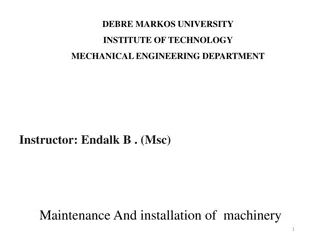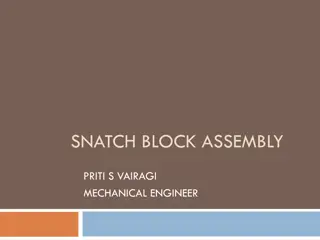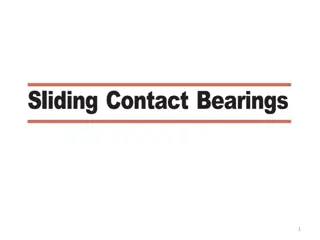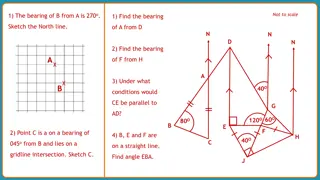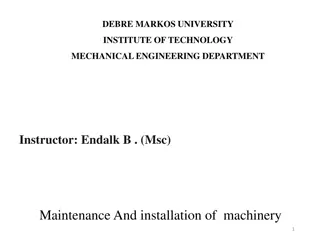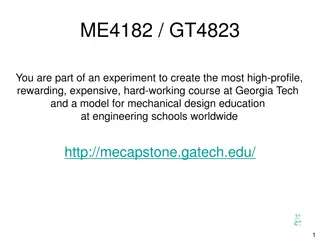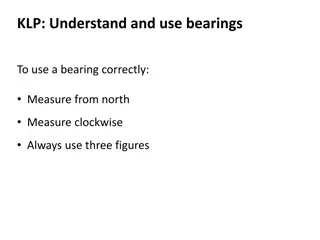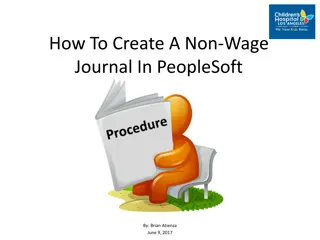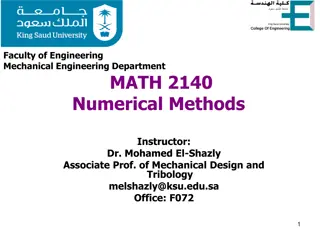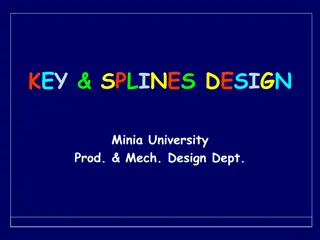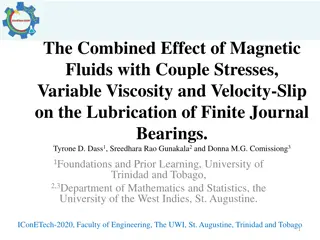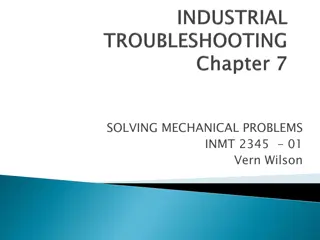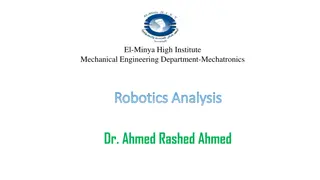Understanding Journal Bearings in Mechanical Design
Journal bearings play a crucial role in mechanical design by utilizing lubrication to minimize friction and wear between rubbing surfaces. This article explores the concept of lubrication, the wedge effect in journal bearings, methods to create a viscous layer, and the parameters affecting generated pressure. The importance of load, shaft speed, lubricant properties, clearance value, and temperature in determining pressure are discussed.
Download Presentation

Please find below an Image/Link to download the presentation.
The content on the website is provided AS IS for your information and personal use only. It may not be sold, licensed, or shared on other websites without obtaining consent from the author. Download presentation by click this link. If you encounter any issues during the download, it is possible that the publisher has removed the file from their server.
E N D
Presentation Transcript
JOURNAL BEARINGS I Dr. Ameer Ali Kamel Prod. & Mech. Design Dept. Faculty of Engineering 1
1. INTRODUCTION The term lubrication involves the use of a lubricant between two rubbing surface to prevent metal-to- metal contact. The presence of lubricant tends to reduce the coefficient of friction and the rate of wear. v P Design29-Assembly of hydraulic cylinder 2
In journal bearing, a wedge will be retained between two running surface on which a pressure will generate between the contact surfaces and separate the surface away from each other. This phenomenon (wedge effect) is like the case of a ship runs at high speed and or similar to a taper shaft pressed on a tree. Wedge Effect 3
However, there are two methods to obtain a viscous layer between the two surfaces, which are: 1.Feeding oil or viscous fluid into the clearance between the surfaces under a pressure capable of equalizing the external forces. 2. By creating certain condition under which this ability arises in the fluid layer itself. 4
The lubricant can be fed into the gap of the bearing at required pressure only by the use of a powerful pressure device through a network of pipes and ways. In general, journal bearing consists of: - Two surfaces (Shaft and Push) - A medium contains oil film. JURNAL SHAFT W W W Pressure lines START REST RUN Design30- Engine bearing 5
The figure shows the positions of the journal bearing at: Rest (v=0) Start (v 0) Steady state running. JURNAL SHAFT W W W Pressure lines START REST RUN 6
It can be noticed that there is a contact between journal (shaft) and bearing (push) at rest and start. Also, a certain eccentricity between the axes of journal and bearing will take place. W JURNAL SHAFT W W Pressure lines START REST RUN 7
It is important to notice that the value of the generated pressure depends on the following parameters: 1. Load on bearing. 2. Shaft speed. 3. Properties of lubricant. 4. Value of clearance between journal and bearing (eccentricity). 5. Temperature. 8
Due to the leakage of the lubricant from the bearing ends, there pressure in the axial direction as shown is a distribution of Bearing W Pressure Distribution Oil Film 9
2. SELECTION OF JOURNAL BEARINGS: The selection of the suitable journal bearing is a function of: 1. The Normal applied load (in N or Ib.) 2. The speed in revolution per unit time (rpm. or rev/sec) 3. The journal diameter (shaft diameter) 10
3. TYPES OF JOURNAL BEARING 3.1 Rubbing plain bearings - This type of bearings is characterized by the ability of runinge in dry running conditions. -It has a limited range of * Load. * Speed. Therefore, these bearings are usually non-metallic and usually made from: - Thermoplastic plastics. - Thermosetting plastics. - Natural and artificial rubber. - Wood bearings. 11
3.2 Plain bearings loads > -Ability bearings. of carrying the rubbing plain - characterized by ability of oil- impregnation. Here, some plastic bearing that impregnated with lubricant can be used besides the metallic bearings. Material is usually porous metal. Material is Design31- Hydrodynamic Journal Bearing 12
3.3 Fluid film plain bearings: This type of bearings is characterized by the use of an oil film between the journal (shaft) and the bearing surface. Here, a hydrodynamic pressure will generate due to the relative movement dragging the viscous fluid into the taper film (Wedge) as illustrated figure. Wedge Bearing Journal Lubricant F Line of Action 13
Detection of the type of bearing that can be used in a certain application can be carried out according to: - The radial load - Speed. - Diameter. Design32- How Lubricants Work 14
100000- d = 500 mm W d d=500 mm 100000- d=250 mm n d=100 mm Rubbing Bearing d=100 mm 10000- d=50 mm Load (Newton) d=50 mm d=25 mm 10000- Plain Bearing d=10mm d=5 mm 1000- Anti-friction Bearing 100- 10- 1 10 100 1000 10000 100000 1000000 Journal Bearing (rpm) 15
100000- d = 500 mm W d d=500 mm 100000- d=250 mm n d=100 mm Rubbing Bearing d=100 mm 10000- d=50 mm Load (Newton) d=50 mm d=25 mm 10000- Plain Bearing d=10mm d=5 mm 1000- Anti-friction Bearing 100- 10- 1 10 100 1000 10000 100000 1000000 Journal Bearing (rpm) 16
It can be notice that the chart is divided into regions. Each region suitable type of bearing that can be used at a certain load and speed. hydrodynamic journal bearing is limited with two lines (Yellow Lines). represents the most The range of 17
4. SELECTION Of JOURNAL BEARING The selection of journal bearings is based on an operating life of 10000 hours. Longer life can be obtained by reducing loads and/or speed. The selection of a journal bearing at a certain load and speed means the finding of the following data: 1. The shaft diameter (Dshaft). 2. The diameteral clearance (Cd) between journal and bearing diameters. D bearing= dshaft+ Cd Also the radial clearance (Cr) is half the diameteral one. 18
3. Bearing width. 4. The suitable type of oil (oil viscosity & oil type) at a certain recommended operating temperature. 4.1 Determination of the Journal Dimensions The range of the hydrodynamic bearings can be shown with details in the following figure. 19
kN kp 200 20000 1. Hydrodynamic 100 10000 Hydrodynamic Boundary 50 5000 Maximum Recommended Load 30 3000 20 2000 Width = 0.6 d 10 1000 2. Dry Rubbing 5 500 Width =d (PTFE+10000 hr) 3 300 2 200 Width =1.5d (graphite+500 hr) 1 100 Boundary 3. Pre-Lubricated 0.5 50 0.3 30 0.2 20 Width =d Pre-Lubricated 0.1 10 Dry Rubbing 60 100 300 600 1000 3000 6000 10000 30000 Rotational Speed (rpm) 20
Important Notes 1. The suitable journal diameter can be determine at the given load and speed. 2. The example shown in the figure means that the suitable journal diameter for a load of 3000 N and speed of 3000 rpm is 50 mm. 3. The figure shows also the suitable range for the hydrodynamic (red lines) and boundary lubrication (yellow lines) where the width of the bearing is: Bearing width (b) = 0.6 d 21
4. Also, without lubricant), the width (b) can be determined from the relation: b= K d Where, K is a material width factor. Therefore, K = 1 for PTFE Bearings. (Life = 10000 hours) K = 1.5 for graphite bearings (Life = 500 hours). for the dry rubbing bearing (i.e. rubbing 5. The pre-lubricated bearings (self-lubricated or oil impregnated bearings) are shown in the chart by doted and dashed white lines. The material width factor for pre-lubricated bearings is the unity. i.e., K = 1 (for pre-lubricated bearings). Design33- Engine Lubrication System 22
4.1 SELECTION OF HYDRODYNAMIC JOURNAL BEARING An accurate determination of the hydrodynamic bearing specifications can be obtained from the following figure. The explained example illustrates the case of a bearing, which loaded with 8000 N and at speed of 550 rpm (9 rev/sec). The journal diameter is about 92 mm. 23
5000 3000 2000 Rotational Speed, rpm 1500 1000 800 600 500 400 300 200 100 10 20 30 40 50 60 70 80 90 100 110 120 130 140 150 160 170 180 190 200 Journal Diameter, mm Hydrodynamic Journal Bearing 24
Grease Lubrication 750 White Metal Lining 500 400 300 Copper-lead Lining Rotational Speed, rpm 200 150 100 75 50 40 30 20 15 10 20 40 60 80 100 120 140 160 180 200 Journal Diameter, mm Boundary lubrication bearings 25
NOTES: 1.Hydrodynamic lubrication over the white line will usually take over. 2.Parallel solid yellow lines present the range of white metal linings. 3.Parallel dotted green lines present the range of copper-lead linings. 4.The area under the dotted red curved line presents the grease lubrication region. 26
750 500 400 300 Rotational Speed, rpm 200 150 100 75 50 40 30 20 15 10 20 40 60 80 100 120 140 160 180 200 Journal Diameter, mm For example: Bearing with load 20000N & speed 60 rpm would have a white metal lining with diameter of 150 mm, width = 0.6 D= 0.6x150= 90 mm 27
4.2 DETERMINATION OF THE DIAMETERAL CLEARANCE (Cd): The diameteral clearance is required to form the wedge area between the journal and bearing areas. Diameteral clearance= Bearing diameter- Journal diameter. Cd = Db- Dj The diameteral clearance can be determined from the following figure as a function of journal diameter Dj and running speed N . 28
6000 4000 3000 2000 Rotational Speed, rpm 1000 800 600 500 400 300 200 100 25 m 80 60 25 50 75 100 125 150 175 200 Journal Diameter, mm Diameteral clearance of journal bearings 29
Lubricant forms Liquids such as: 1) Turbine oil. 2) Heat transfer oils. 3) Gear oils. 4) Metal cutting oils. Semi- solid lubricants (greases) Solid lubricants ( graphite and PTFE). Lubrication- Principles of Lubrication - sample 30
Lubricant Characteristics Lubricant characteristics can be summarized into the following items: 1.Viscosity 2.Viscosity index 3.Pour point 4.Flash point 5.Fire point 1.Viscosity It is defined as the resistance of fluid to flow. It is affected the oil temperature and oil pressure. 31
2. Viscosity Index It is the decrease temperature change. 3. Pure Point It is the temperature at which the oil begins to change its state from liquid to gas. 4. Flash Point It is the temperature at which the oil vapor begins to ignited for short period. in the oil behavior with 5. Fire Point It is the temperature at which the oil vapor produces continues ignition. 32
4.3 Determination of the type of oil 1. Initially, the suitable oil viscosity is determined as a function of the rotational speed (N) from the following figure. 100 50 Viscosity ( ),CP 20 10 5 1 100 200 500 1000 5000 10000 2 3 4 5 Rotational speed (N), rpm 33
2. The Type of the oil or the oil grade can be obtained as a function of the viscosity and the operating temperature from the following curve. 1000 300 200 Absolute Viscosity, centipoise 100 60 50 40 30 Types of Lubricating Oils. 20 18 15 12 10 SAE-70 SAE-60 SAE-50 SAE-40 SAE-30 8 6 SAE-20 SAE-10 5 30 40 50 60 70 80 90 100 Temperature, oC 34
Aims of Usage Lubricant Protect critical components which have relative velocities. Provide reliable operation. Lower maintenance costs. Decrease downtime. Increase equipment life. Reduce friction and wear rate. Design35- Lubricaton system in cars Design36- Oil in Your Engine 35
EXAMPLE (1) For a certain main shaft, the radial reaction is calculated from the balance equation and found to be 8000 N. The shaft diameter is calculated from the strength equation (Shaft design) and found to be 80 mm The shaft speed is 1000 rpm 36
SOLUTION 5000 3000 2000 Rotational Speed, rpm 1500 1000 800 600 500 400 300 200 100 10 20 30 40 50 60 70 80 90 100 110 120 130 140 150 160 170 180 190 200 Journal Diameter, mm Hydrodynamic Journal Bearing 37
EXAMPLE (2) For a certain main shaft, the radial reaction is calculated from the balance equation and found to be 30000 N. The shaft diameter is calculated from the strength equation (Shaft design) and found to be 150 mm. The shaft speed is 1000 rpm. 38
SOLUTION 5000 3000 2000 1500 Rotational Speed, rpm 1000 800 600 500 400 300 200 100 10 20 30 40 50 60 70 80 90 100 110 120 130 140 150 160 170 180 190 200 Journal Diameter, mm Hydrodynamic Journal Bearing 39
END 40


